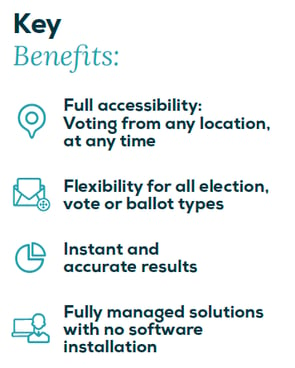Start by determining the features you need for your online voting event
You need to hold your next university leadership elections using an online voting system. And your board of directors wants to hold its upcoming general meeting online — can you use the same solution?
With many online voting solutions on the market offering various features, and with the many different events held by university groups each year, these questions will come up. To determine which online voting option is best for your event, let’s begin by looking at what all online voting systems (should) offer, then we can discuss some key differences between solutions.
The Basics
Any online voting solution worth considering should come with a set of basic features to ensure the accessibility, simplicity, and security of your event. For example, voters or meeting attendees should be able to cast votes and ballots from any internet-connected device they choose, including computers, laptops, tablets, and smartphones. This guarantees ease-of-use and allows all participants to access the platform however they prefer.
Online voting solutions should also offer flexibility when it comes to election, vote, and ballot types. In other words, you should be able to implement an online voting system into your elections and meetings without changing much about how they are conducted, other than, of course, that voting takes place online. A qualified online voting solution can accommodate weighted and proxy voting as well as multiple ballot and question types, such as multiple choice, ranked voting, and write-in options.
While the exact security features that go into an online voting solution do vary, at the very least you should be assured that only eligible voters or meeting attendees can participate in your event through the online platform, and that their votes cannot be changed once they are cast. While there are numerous protocols that can ensure these things, we recommend asking any potential provider about two-factor authentication, digital signatures, vote confirmation receipts, and vote encryption.

Finally, online voting solutions should be able to provide you with results from your voting process much faster than manual paper vote counting. While exact times depend on a variety of factors both within the solution and the nature of your event, results calculation should be both quick and accurate.
The Difference
Online voting solutions are typically grouped into one of two camps: online voting for elections, and online voting for meetings, assemblies, and similar decision-making events. While these two kinds of solutions share the basic online voting features detailed above, there are some notable differences between the two to consider.
Online Voting for Elections
Online voting solutions intended for use during elections are typically designed to allow voters to cast their ballots from any location, on any internet-connected device, and at any time during the election. This means that, once the election begins and voting is open, eligible voters can log on to the voting portal, view and fill out their ballot, and cast their vote at any time before voting closes.
Online voting systems for elections also tend to have a more robust security framework than those designed for meetings. While solutions designed for meetings should still guarantee the integrity of votes and overall security of your event, elections often have higher stakes and require added measures to protect voter privacy and anonymity, and to ensure transparency and auditability.
Online Voting for Meetings
Online voting during meetings and assemblies can be thought of as more dynamic than online voting in elections. In an election, voters can choose to cast their ballot whenever they like during the voting period, which can extend across multiple days. During a meeting, however, voting typically occurs within just a few hours. Moreover, voting is often conducted in a “live” manner, meaning that a particular agenda item or topic is brought up, discussed, and voted on before moving on to the next. Because of this, online voting solutions have been designed specifically to help make this live decision-making process efficient and streamlined.
Managing an event through an online voting solution designed for meetings will be much more like organizing an agenda than creating a ballot. Agenda items are added to the online voting platform with all relevant information, and members log on when the meeting begins to view items and vote. Often, these online voting solutions offer you the flexibility to open items for voting one at a time, allowing you to control the pace of the meeting, or to open all items at once.
Finally, online voting solutions for meetings and assemblies should also integrate with a video-conferencing solution. This ensures that participants can still engage in a familiar meeting experience if they are participating virtually and remotely.
Whether you are holding a university-wide election, or your alumni association is holding a yearly meeting, online voting can help you simplify and streamline any event. Scytl offers both Invote, an online voting solution for elections, and Meeting Manager, a live online voting option for meetings and assemblies. To learn more about how universities can benefit from online voting technology, check out our previous blog article and head to our website.

